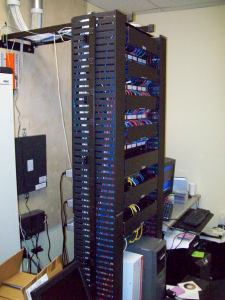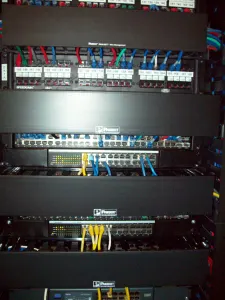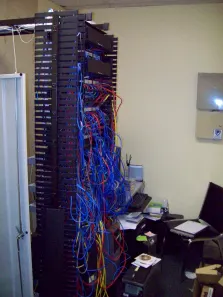Got Cables? (part 2)
How could you have avoided this?
Well, if you’re in the Bay Area you could have called me at Dicar Networks and we could have done an “inspection” of the existing cable infrastructure to see if it’s in good shape and usable for your application. If you’re in another area, just call a local low voltage cabling contractor. Most companies that do phone system installations or IT services can also help with this. You wouldn’t move into a new home without an inspection, would you? Then why would you move into a new office without making sure all of the things you need are working, especially your phone and internet which is the lifeblood of most businesses?
Why aren’t the cables there?
You’re not alone, most people are confused and upset when they find out that the existing jacks don’t have cables behind them. There could be several reasons why the cables are missing, or cut:
1. The building or office has been remodeled and the cables had to be cut and/or removed during the process. Landlords and property managers are finding it easier to lease smaller office spaces these days, so they will often remodel a large office into several smaller offices that are easier to lease. Chances are good that they had no choice but to cut the existing cables in the process. Most people are surprised that they don’t install new cables, but there are several good reasons why they don’t, the biggest is because it costs money. And even if they spent the money to do it, it might not be the cables you want, or in the locations you want, and might have to be redone anyway…and thus a waste of money. So they usually let the new tenant take care of their own wiring needs.
2. Almost 10 years ago now, as I’ve mentioned in prior blogs, “abandoned cable” became a code violation. A simple way to picture this is that a cable has 2 ends, if both ends are not connected to something it’s considered abandoned cable, and accoring to the California Electric Code is has to be removed. So let’s pretend you are moving out of your existing office space where you have an equipment rack with some patch panels where the cables connect, and you don’t want to buy new patch panels for your new office at $200-$300 a piece, so you remove the cable and take them with you. Well now those are considered abandoned cables and according to code, have to be removed. Often times when those cables get removed, rather than buying “blank” faceplates, the jacks are reinstalled without the cables connected.
Next time you’re looking at office space and you see existing jacks and faceplates you plan on using, make sure you GOT CABLES!
Got Cables? (Part 1)
Here’s a situation that happens all too often these days…
Your company has spent the last few weeks or months looking for new office space and has finally found the perfect location. The office is setup just how you want, with a little room to grow, and you (or your real estate broker) negotiated a good lease and maybe even got the landlord to install new carpet and paint. The office already has phone and internet jacks located around the office, so except for moving in, you don’t have too many upfront expenses.
But wait…
When you go to use those existing telephone and network jacks…they don’t work. You try one after another until you’ve tried every jack in your office, and none of them work. You finally accept the fact that you’re going to have to call your cabling or IT company to “activate” those jacks, and accept that they will bill you for a few hours labor to do so.
But wait…
When you’re cabling or IT company can’t find the “other end” of the cable that attaches to those existing jacks, they decide to take off that existing faceplate, and what do they find? Often time there are no cables connected to the jacks, or if there are, they are cut somewhere up in the ceiling and can not be used.
Now what? What does this mean?
It means that while you were excited about the new carpet and paint, you forgot to do your “due diligence” and make sure those existing jacks in the wall were connected and usable. It means that the great deal you got on the lease of your great new office is going to cost you anywhere from a few hundred to a few thousand dollars or more to get the cables installed where you need them, depending on the size of the office and the number of cables.
Why aren’t the cables there?
Check back for Part 2 to read remainder of this story.
Is Your Network Rack Costing You Money?
A lot has happened since my last blog. As I write this I am anxiously awaiting a call from my wife telling me to hurry home…our first child is due any time now.
I would like to say congratulations to a couple friends and former teammates of mine who will be playing in this year’s MLB Allstar Game in St. Louis: Hunter Pence and Ben Zobrist.
OK…let’s get on with it.
Does your network rack look anything like this?
If so, chances are it’s costing you money.
Messy racks like this make it harder to trace cables and determine what port on the patch panel and/or switch they are connected to. Also, it makes it very difficult to add, remove, or test equipment; let alone adding new cables for new desks and employees.
For most companies it is hard to justify paying someone to come in and “clean up” your network rack, after all it’s probably not out in the open for people to see, right? Of course not, it’s hidden in your Telecommunications or Equipment Room (more often referred to as the Server Room) where no one goes except your IT staff or outsourced company.
So how much is it costing you?
Well, that is hard to say exactly, but you can bet that every job that requires someone working on or around your rack takes longer than it would if your rack was neat and orderly. If you’re talking about adding or removing equipment from a rack like this, your labor time could be double. And with cabling rates costing as much as $100/hour and IT services costing as much as $150/hour or higher, wouldn’t it make sense to invest the small amount of money it would take to have a rack like this professionally “cleaned up” and start saving money on every future job?
Of course it would, and here’s what it looks like now…


Importance of a UPS…Are You Protected?
Is your critical electronic equipment protected from power surges?
Can your employees still conduct business during a power outage?
If your answer was “no” or “I don’t know” to either of these questions, you owe it to your business to keep reading. First let’s talk about the electrical “power surges.” Take a moment to look around your office at all of the electronic equipment (computers, printers, copiers, phone system, servers, switches, televisions/monitors, etc.); now think about how much money was spent on all of that equipment. If it’s a “home” office it might be a few thousand dollars, if you’re in a large corporate office it might be hundreds of thousands of dollars. Everyone has seen and probably used a “power strip” that not only gives you extra outlets, but also protects the connected equipment from power surges. Every piece of electronic equipment, including your TV and DVD or Blue Ray player at home, should be protected with a surge protector. I won’t get into the details here, but you can buy a surge protector for $5-$10, or you can spend hundreds; some will even buy you new equipment if it’s damaged while plugged into their surge protector. Do some research to determine how much protection you need.
So now that your equipment is protected from power surges, what happens when there is no power at all? Does your business come to a screeching stop? Do you count the money you are losing as the minutes pass by on your [battery powered] watch?
What would it be worth to your business if you could keep your phones (and other equipment) working during a power outage? Would you save money on unproductive employees? Would you have more sales? More “happy” customers?
Connecting your critical equipment (phone system) to an uninterruptible power supply (UPS) would allow you to continue to make and receive calls during a power outage. Connect your servers, computers and printers and now you have a fully operational business while your competitors are updating their MySpace or Facebook status from their cell phones. The bonus is that most uninterruptible power supplies also offer surge protection, so you just need the one piece of equipment.
Let me illustrate this point for you with a true story that happened recently. A medical office had a power surge followed by a short power outage. The surge fried the hard drive and one of the cards in the phone system that cost nearly $1,200 to replace. If they had a UPS, their phone system would have been just fine, and they could have used the phones during the power outage. There is no way to measure the number of calls missed or customers lost during the downtime. The irony of the story is that the medical office had already purchased a UPS to connect with their phone system, but never took the 5-10 minutes to install it. The UPS was still in the box on the floor when the technician arrived to repair the phone system.
Learn how to protect yourself by calling Dicar Networks at 408-850-6400, or www.DicarNetworks.com.
Get future updates by following me on Twitter at www.Twitter.com/john_fagan
Have questions or comments that you would like to see addressed in future blogs, leave a comment?
You Get What You Pay For…
Everyone has heard the old saying, “You get what you pay for.”
In the cabling world, I get the feeling there is a lot of
“How hard could it be?” and “They can’t be that bad.”
These are probably the thoughts of someone who is basing their decision of what voice and data (low voltage) contractor to use solely on the lowest price. Now I am sure there are companies out there that have selected the lowest price bid and were extremely satisfied with the work, just as I am sure there has been times when the most expensive bid was chosen and did a terrible job; there are always going to be exceptions. I expect most individuals and companies don’t know what to look for, or what questions to ask when seeking bids for their cabling projects.
Use the following list/questions to assist you in selecting a qualified company/contractor for cabling, phone systems, video surveillance, networks, audio/video (and many other services):
1. Are they licensed? You can check the type and status of a California contractor’s license at the Contractors State License Board website (www.cslb.ca.gov).
2. Do they carry workers compensation insurance? While you are on the Contractors State License Board website, make sure the contractor has current workers compensation. If they don’t, your company could be held liable should an injury occur on the job site.
3. Ask for references and pictures. Of course, a company/contractor is not going to give you a reference that they don’t think is going to say good things and help them get the job, and they’re not going to show you ugly pictures of work they’ve done, but at least you’ve made them produce these things and at the very minimum done your due diligence. Now if they do a bad job and your boss asks why you chose them, you have covered your butt.
4. Experience. How much experience does the company/contractor have? Do they have any certifications related to the work that makes them more qualified than the competition? When it comes to “information transport systems” and cabling, BICSI is the professional association supporting the industry with information, education and knowledge assessment for individuals and companies. Find out if the company employs any RCDDs or BICSI certified installers.
5. What additional services can they provide? Are there additional services or products that you need now, or will need in the future? Most people find it much easier to have one company that can provide multiple services/products (especially if the services/products work together), than to have different companies provide them and have to coordinate with the different companies and staff.
Think of it as an interview process. If you were hiring for a position within your company, wouldn’t you want to hire an individual that is qualified, dependable and trustworthy? Well if that’s true, don’t you want the most qualified, dependable and trustworthy company working on your cabling, phone system, surveillance system, network, etc.?
I’m not that naive to think price won’t play a part in your decision, and it should, but make sure you look at the big picture…or you may “unhappily” be saying, “I got what I paid for.”
Get future updates by following me on Twitter at http://www.twitter.com/john_fagan
-
Recent
-
Links

